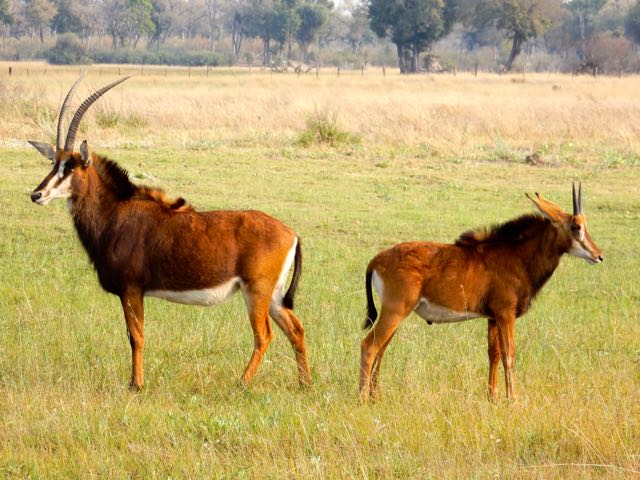 |
| We had a visitor in our room. |
After leaving Botswana we spent a night at Oliver's in Lowveld, South Africa. We had an unexpected visitor in our room the next morning. I was grateful that I hadn't seen our new "friend" before going to sleep.
 |
| This is a rain spider. They are completely harmless and appear when it rains. |
Royal Malewane was the final camp and touted as the most luxurious of our accommodations. We flew into Kruger International Airport. Kruger National Park's western boundary is made up of private game reserves which combine with the Kruger to create one of the world's largest game reserves. While in Botswana our driver was also our tracker, teacher and guide. They carried no weapons. Up to three vehicles could view an animal at a time. In Kruger we always had a tracker seated in front of the jeep and a driver who explained everything to us as we drove along. By law they were required to carry a high powered rifle that would only be used in case of an emergency. I don't believe that any of our guides had ever used their weapons while on a game drive. Only two vehicles were allowed to be around the animals at one time.
 |
| Our tracker is perched on a seat in front of the jeep. He gets up close and personal with the animals. He will on occasion leave the vehicle to go tracking on foot. |
 |
| Tom decided his next career is as a tracker. |
 |
| The elephant has amazing dexterity with the end of his trunk. He uses it like fingers. |
 |
| Elephants love eating the bark off of trees. Here the trunk is used to roll the branch around in his mouth as he chews off the nutritious outside bark. |
 |
| Watering Hole. |
While observing a group of elephants, a couple of teenagers started acting like teenage boys do no matter what the species. One kept playfully bumping the other. The problem was one of the elephants almost landed in the jeep with us.
 |
| Tom was worried he was going to be squished by the playful elephant. Our friend in the seat behind Tom almost landed in his wife's lap! |
The roads throughout the reserve are continually being maintained. This equipment was left near the elephant's watering hole. Elephants are known to be very intelligent animals. We watched with fascination as this matriarch carefully examined the tractor. You would have thought her trunk was a third eye. She moved her trunk carefully up and down the tractor learning about it and making sure it wouldn't harm her family.
 |
| The matriarch was learning about this new "thing" next to the watering hole. |
 |
| She carefully examined the tractor from top to bottom. |
Here are some pictures of the many types of antelope we saw.
 |
| Nursing baby. |
Normally we returned to camp for lunch. One drizzly chilly day we were surprised by lunch out in the "bush."
 |
| We were provided with ponchos which helped keep us warm. While traveling around searching for animals we also had hot water bottles which were wonderful. |
 |
| A feast was being prepared for us. |
 |
We were treated like royalty out in the bush.
|
There were a variety of birds which we enjoyed.

 |
| This bird lays her eggs in the sand! |
With animals like this crocodile laying around it's a wonder the species of birds laying eggs in the sand has survived.
We were fortunate to see more young leopards. A brother and sister practice their stalking skills on each other while waiting for their mother to return.
 |
| Waiting for mommy to return. |
 |
| This leopard wasn't the least bit concerned that we were watching her. |
























































































